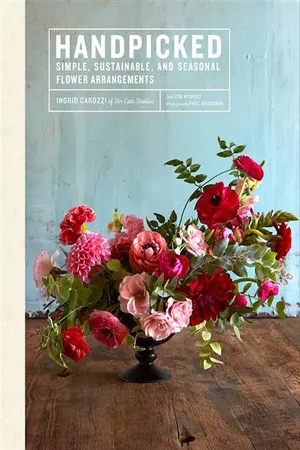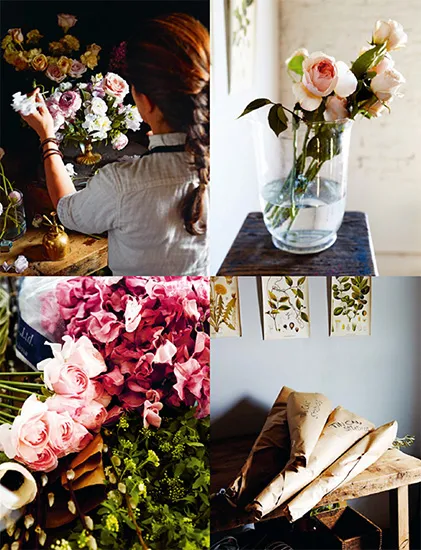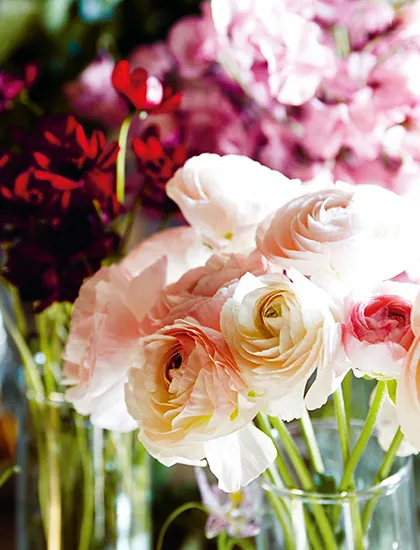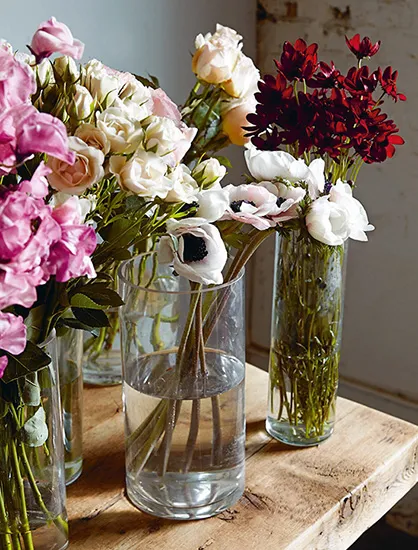![]()
FLOWERS AND VASES
Take Care of Your Flowers
Flowers are delicate and need careful attention and respect. If you take the time to treat them right, they will thrive in your arrangements and last longer. Even wilting flowers can perk up with the appropriate care.
First, as soon as you get your flowers home and unwrap them, cut the stems, remove any leaves that would be below the water level, and put the flowers in water immediately. Allow them to drink the water for at least an hour before you arrange them.
Flowers are not all the same. By looking at their stems, you can determine the appropriate water temperature:
• Flowers with soft stems, such as tulips, daffodils, and irises, like cold water.
• Flowers with medium-soft stems, such as carnations, mums, lilies, and peonies, like lukewarm water.
• Flowers with hard or woody stems, such as roses, lilacs, and hydrangeas, like warm water.
• Mixed arrangements do best in lukewarm water.
Second, make sure to add plant food to the water. So don’t throw away those little bags of plant food you get when you buy packaged flowers. They provide important nourishment and kill harmful bacteria that make flowers wilt prematurely. If you’re buying loose flowers, make sure to buy your own plant food.
Third, make sure the vase that you are using for your arrangement is clean, as bacteria limit the life span of your blooms, and then fill the vase with water and plant food before you start arranging.
Finally, I use a spray bottle to mist all of my arrangements a couple of times a day to hydrate the petals. This makes them look fresher and last longer. I also like to freshen up my flowers before I photograph them. Keep the spray bottle at least 1 foot (30 cm) away from the flowers. You don’t want to shower them, just give them a mist!
My Favorite Blooms
1 ORNITHOGALUM
2 SWEET PEA
3 TULIP
4 ROSE
5 RANUNCULUS
6 STOCK
7 PEONY
8 LISIANTHUS
9 DAHLIA
10 ANEMONE
11 CHOCOLATE COSMOS
12 HELLEBORE
About My Favorite Blooms
ORNITHOGALUM
This asparagus relative is not as tasty as its family member but is much more beautiful. Ornithogalums come in many different varieties. I love them and use them when I want to add height or have blooms draping off the sides of an arrangement. Look for them in late spring or early fall.
• Ornithogalums have soft stems. Cut them before putting them in cold water.
• The tiny blooms along the stem tend to open in stages and often outlast the other flowers in the arrangement. Just move them into a new arrangement!
SWEET PEA
According to legend, Francisco Cupani, a Sicilian friar, discovered this pretty little flower in the late 1600s and had its seeds shipped to England, where it quickly became popular. The oldest variety is dark purple and not the pink and white we see most often now. Sweet peas are easy to find in the spring and early summer.
• Sweet peas have tiny brittle stems that snap easily. Cut them and put them in lukewarm water immediately so they don’t breathe any air into those tiny stems.
• Use plant food and change the water every day.
TULIP
I love tulips in every color, shape, and form, except when they are all cut to the same height, standing like soldiers in a tight vase. They usually appear in late winter and stay through spring.
• Tulips have super-soft stems. Cut them before putting them in cold water. They also drink like crazy, so check them every day.
• Don’t place them next to fruit of any kind. Fruit produces ethylene, a gas that these blooms are very sensitive to.
• Tulips continue to grow after they are cut and placed in a vase and open gradually, resulting in a different-looking arrangement every day.
• On this page, I show how you can work with tulips and change their form.
ROSE
There are so many beautiful varieties, and roses can be arranged in countless ways. Most roses are imported and available all year round. Juliet roses, tea roses, and garden roses are my favorites. In my eyes the blooms hold all the beauty, so I like to cut them short to hide most of the stems.
• Roses have hard stems. Cut them and place them in warm water immediately.
• They are sensitive to bacteria, so remove all leaves that would otherwise be in the water.
• Before arranging, remove the thorns so they don’t harm their neighbors.
• Try not to touch the rose petals when arranging. They bruise easily!
• Make sure to put each rose in water immediately after trimming it; air in the stem will make the rose bend in the vase.
• Your roses will last longer if you keep them cool overnight. An unheated area is best.
RANUNCULUS
With hundreds of pastel-colored petals forming a perfect sphere, the ranunculus is one of the most beautiful flowers on the planet, and I use them all the time. They appear at the market naturally from February to May, though if I ever stray from buying in-season, it is to score some ranunculus! Take proper care of them and they can last up to three weeks, getting more beautiful with each day.
• Ranunculus have medium-soft stems. Cut them before putting them in lukewarm water.
• Remove all leaves that would otherwise be in the water.
• They are not fond of heat or direct sunlight; the cooler the better.
• They drink a lot of water but don’t like wet stems! So change the water often, but fill only halfway up.
• Don’t store them next to fruit of any kind. Fruit produces ethylene, a gas that these blooms are very sensitive to.
STOCK
Stock is one of the most common types of garden flowers. They come in a variety of colors and can be found almost any time of the year. They are resilient and great when you are looking to add a bit of texture to your arrangement.
• Stock flowers have fairly hard stems. Cut them before putting them in lukewarm water immediately.
• They are easy to take care of. Just pinch the tiny blooms off the stem as they wilt.
PEONY
Originally from Asia, these showy beauties are cultivated everywhere and bloom in la...





